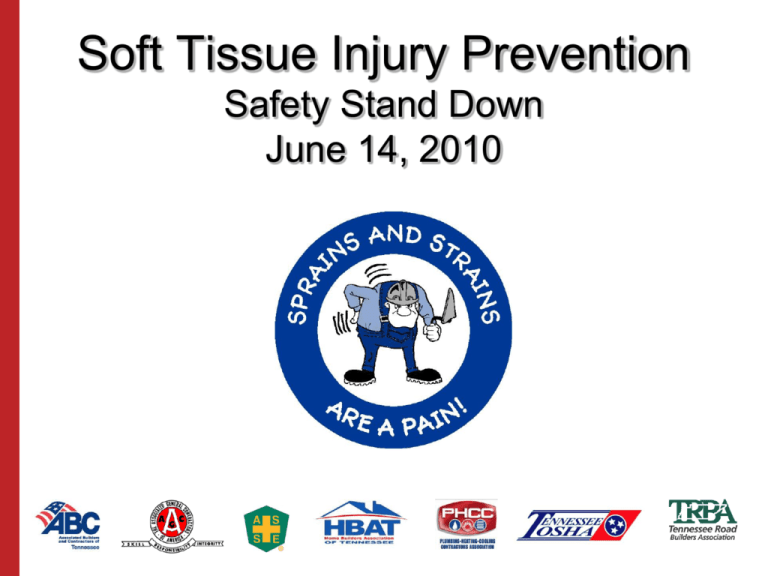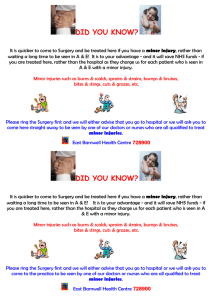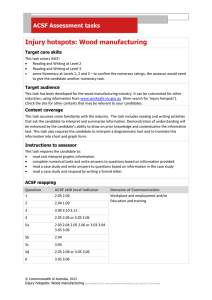Soft Tissue Injury Prevention
advertisement

Soft Tissue Injury Prevention Safety Stand Down June 14, 2010 What are soft tissue injuries… • Soft tissue injuries are injuries that affect your muscles, nerves, tendons, ligaments, joints and spinal discs. • This is the most prevalent type of injury in the construction industry! • Although not fatal, these types of injuries can be disabling preventing an individual from leading a normal lifestyle and in some cases living with constant pain. Why is soft tissue injury training so important? • 30 percent of the construction industry’s workers’ compensation claims • 70 percent of total workers’ compensation losses We can prevent 1/3 of all work related injuries! Sprain or strain injuries accounted for 39% of total injury and illness cases requiring days away from work in 2008! Other (25.3%) Sprains and strains (38.6%) Heat & chemicals (1.4%) Punctures (1.2%) Multiple injuries (4.1%) Soreness, pain except back (4.3%) Bruises and contusions (8.7%) Fractures (8.3%) Cuts and lacerations (8.1%) On average, sprains and strains required 9 days away from work! You body works like a well oiled machine… Just like cranes and other equipment you depend on everyday, our bodies have to be maintained and operated within their limitations. •Machine condition = your physical condition •Operational limitations = your physical ability •Load capacity = your strength limitations Know your body’s limitations – Don’t overload the machine! Don’t let this be you…… • Example: A building worker who has worked on construction sites since the age of 14, using drilling and pneumatic hammers three or four days a week for several hours, now suffers from an occupational disease. At the age of 42, the pain in his wrist is so severe that he can no longer work. • Example: A machine operator, who has driven an excavator and loader every day for some 20 years, has had to give up his job because the pain in his back is so severe. This situation could have been avoided if he had used a modern, well-designed and adjustable seat on his vehicle and limited his exposure; for example, by rotating jobs. Examples of soft tissue injuries include: • Sprains (an injury to ligaments that is caused by being stretched beyond their normal capacity and possibly torn) • • • • Strains (a stretching or tearing of muscle or tendon) Nerve Damage Crush Syndrome Sciatica (pain, weakness, numbness, or tingling in the leg) • Tendonitis (inflammation of a tendon) • Bulging or Ruptured Disk • Bursitis (inflammation of the fluid-filled sac (bursa) that lies between a tendon and skin, or between a tendon and bone) • Carpal Tunnel Syndrome Symptoms of Soft Tissue Injuries – Less strength for gripping – Less range of motion – Loss of muscle function – Inability to do everyday tasks – – – – Sore muscles Strains/Sprains Bruises Pinched nerves Primary Causes of Soft Tissue Injuries • • • • • • • • • Repetitive motions Awkward postures Forceful exertion Contact stress Prolonged vibration Excess body weight Slips/Falls Struck by Ask participants to name Caught in tasks that they perform that could result in a soft tissue injury. Repetitive Motions • Tasks with high repetition rates can become a source of injury even when the required forces are minimal and normally safe. Examples: • Raising and lowering your arm over and over again while using a table or concrete saw • Using tools like a hammer, screw gun, caulk gun, etc. Repetitive Motion: Controls • Rotate job duties • Use power tools instead of hand tools when possible • Tool tips: – Avoid tools with finger grooves – Tools with offset handles can help keep the wrist straight – A tool handle shouldn’t be so short it presses continually into your palm – Soft grips and spring loaded handles are a plus Awkward Postures An awkward posture is one Examples include: in which any part of the body •Picking up a load over the is under strain due to its side of a pickup truck unnatural or extreme position. •Bending over to finish concrete or tie rebar •Working in a tight area •Working overhead Awkward Postures: Controls •Try to position yourself so your work is waist high by doing things like placing saws on tables rather than on the floor. •Use scaffolds, lifts or ladders to elevate you to your work. •Plan the layout of laydown and storage areas to provide easy access and reduce the number of times materials need to be moved. Simple Solutions: • Use tools with extensions like bit extensions for drills to eliminate the need to bend so far forward or reach so high. Forceful Exertion • Force is the amount of Examples: effort it takes to perform • Repeatedly turning a a task, such as pushing, screwdriver while pulling or gripping a tool. pushing at the same time. • The more force you have • Repeated pressure on a to exert, the greater the finger when pressing the stress on your body. trigger on a power tool. • Lifting an excessive amount of weight. 45% of sprains and strains are the result of overexertion. Forceful Exertion: Controls Examples: • Utilize mechanical devices to lift or support loads • Ask for help with a heavy or awkward load • Use power tools instead of hand tools when possible • Select tools with larger grips and bigger triggers • Select products such as: • Lightweight concrete block • ½ weight bags of portland cement Simple Solutions: • If a tool has a narrow handle, wrap it with compressible foam to improve grip. • Use quick-threading lock nuts to reduce twisting motions. BACK FACTS: 40% of sprains and strains injure the BACK! •Your waist acts like the fulcrum in a lever system, on a 10:1 ratio •When you add in the 105 pounds of the average human upper torso, you see that lifting a 10 pound object actually puts 1,150 pounds of pressure on the lower back. •If you were 25 pounds overweight, it would add an additional 250 pounds of pressure on your back every time you bend over! Use Proper Lifting Techniques! • Estimate the weight of the load before lifting. • Stand close to the load, squat down bending at the knees, put the hands firmly under the object and keep it close to the body during lifting. • Make the lift smoothly lifting with the legs, keep the back straight, the chin up and the load close to the body. Have someone demonstrate the right way to lift. • If you must turn while carrying the object, turn using your feet, do not twist the body. • Reverse this order to place the object below waist level. Remember: Back injuries are preventable. Contact Stress • Caused by contact with hard objects or surfaces Examples: • Working on your knees • Hitting something with your hand • Carrying something and supporting it on your shoulder or head • Standing/working off ladders and rubbing soft tissue • Using tools like tin snips that require a lot of pressure Contact Stress: Controls • Use knee pads or kneeling creepers when working on your knees • Shoe inserts for prolonged standing • Wearing gloves to protect from sharp, hard objects • Use ergonomically designed tools with cushioned grips • Use the correct tool for the job Prolonged Vibration Examples: • Use of vibrating tools – jack hammers – Impact drills – tamps • Mobile equipment – – – – Scrapers Dump Trucks Drilling equipment Hoe ram Prolonged Vibration: Controls • Use anti-vibration gloves • Use reduced vibration tools • Use cushioned grips on tool handles • Use padded seat cushions • Keep hands as warm as possible when using a vibrating tool to maximize blood flow. • Keep as light a grip as safely possible on the tool Slips/Falls • Watch out for trip hazards • Trash and debris, esp. items like conduit or pieces of hanger rod create hazards for everyone in the building • Watch for slick surfaces • Make sure lighting is adequate • Don’t jump from equipment • Use three points of contact when climbing • Wear fall protection when required! Struck by • Wear hard hats and safety glasses and watch out for falling objects. • Ensure mobile equipment has functioning back-up alarms. • Post and barricade areas with overhead hazards. • Install toeboards where needed. • Inspect and follow proper rigging procedures. • Don’t walk under scaffolds, suspended loads, lifts, etc. • Follow established traffic control procedures and wear a reflective vest when working around traffic. ALWAYS be observant and cautious when moving around a construction site. Caught in/between • Assure all guards for equipment and machines remain in place. • Lock out machines and equipment when making repairs. • Be aware of the lift mechanism on scissor lifts and other equipment pinch points. • Make sure the swing radius of cranes and other rotating equipment is barricaded. • Ensure that trenches are properly sloped or shored. Remember, soft tissue injuries can be prevented by controls that . . . • Limit the amount of force you have to apply to get the job done • Reduce vibration • Eliminate contact with hard, sharp surfaces • Keep your body parts in a natural posture as much as possible • Reduce repetitive motion Additional Considerations: • When working in awkward positions, stretch often. • Keep yourself in good physical shape. • Give your muscles and tendons time to rest and heal following a tough day. Summary • Each of you perform numerous activities every day that have the potential to result in some type of soft tissue injury. • It is important that you take time to recognize when these potential dangers exist and really look at ways to do the job in a safe way. • Most importantly – listen to your body! It tells you when you are doing things you shouldn’t be doing. • We all know someone whose life has been significantly impacted by something like a severe back injury – DON’T LET IT HAPPEN TO YOU! Safety is everyone's responsibility — ALL of the time. Lets work together to prevent sprains and strains and other soft tissue injuries! You can contact the following for additional information on injury prevention: Call 1-800-249-8510 or go to their website at www.state.tn.us or www.osha.gov OR INSERT YOUR LOGO Your (association) representative at (phone)/(email)/(website)



